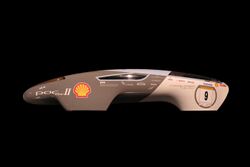Engineering:Pac-car II
Pac-Car II was developed as a student project at ETH Zürich (Swiss Federal Institute of Technology). Based on a group of students and an experienced team leader, the goal was to build a vehicle that uses as little fuel as possible. By using hydrogen fuel-cell, developed at ETH/PSI (Paul Scherrer Institute), as power source, pure water is the car's only emission. Clean mobility completed therefore the educational and energy saving aspects of the project.
Features
- Aerodynamic (drag coefficient of 1px;">d=0.075, Af=0.254 m²)
- A lightweight body (total mass of 29 kg, carbon fibre materials)
- Low rolling resistance of Michelin's Radial Tyres (Cr=0.0008)
- Efficient powertrain (almost 50%)
- Use of simulation and optimization tools (CFD, FEM, MATLAB and Simulink, GESOP)
World record
In 2005 on June 26, the PAC-Car II set a new world record[1] in fuel-economy of 5385 km/L gasoline equivalence during the Shell Eco-Marathon in Ladoux, France . During its third race over 20.6 km the car consumed approximately 1 g of Hydrogen driving at an average speed of 30 km/h (roughly 18.6 mph). This corresponds to 0.0186 L/100 km (15,200 mpg‑imp; 12,600 mpg‑US) gasoline equivalence. This record is certified by the Guinness Book of World Records.[2]
References
- ↑ "ETH - PAC-Car II - World Record". 7 October 2007. Archived from the original on 1 February 2010. https://web.archive.org/web/20100201175558/http://www.paccar.ethz.ch/news/index. Retrieved 29 September 2009.
- ↑ "Travel and Transport/Cars/fuel-efficient". guinnessworldrecords.com. Archived from the original on 20 July 2006. https://web.archive.org/web/20060720152322/http://www.guinnessworldrecords.com/content_pages/record.asp?recordid=43581. Retrieved 28 June 2015.
External links
 |


